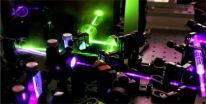(Press-News.org) Researchers at the University of Texas Medical Branch at Galveston by growing vaginal skin cells outside the body and studying the way they interact with "good and bad" bacteria, think they may be able to better identify the good bacteria that protect women from HIV infection and other sexually transmitted infections.
The health of the human vagina depends on a symbiotic/mutually beneficial relationship with "good" bacteria that live on its surface feeding on products produced by vaginal skin cells. These good bacteria, in turn, create a physical and chemical barrier to bad bacteria and viruses including HIV.
A publication released today from a team of scientists representing multiple disciplines at UTMB and the Oak Crest Institute of Science in Pasadena, Calif., reports a new method for studying the relationship between the skin cells and the "good" bacteria.
The researchers are the first to grow human vaginal skin cells in a dish in a manner that creates surfaces that support colonization by the complex good and bad communities of bacteria collected from women during routine gynecological exams. The bacteria communities have never before been successfully grown outside a human.
The research group led by Richard Pyles at UTMB reports in the journal PLOS One that by using this model of the human vagina, they discovered that certain bacterial communities alter the way HIV infects and replicates. Their laboratory model will allow careful and controlled evaluation of the complex community of bacteria to ultimately identify those species that weaken the defenses against HIV. Pyles also indicated that this model "will provide the opportunity to study the way that these mixed species bacterial communities change the activity of vaginal applicants including over-the-counter products like douches and prescription medications and contraceptives. These types of studies are very difficult or even impossible to complete in women who are participating in clinical trials."
In fact, the team's report documented the potential for their system to better evaluate current and future antimicrobial drugs in terms of how they interact with "good and bad" bacteria. In their current studies a bacterial community associated with a symptomatic condition called bacterial vaginosis substantially reduced the antiviral activity of one of the leading anti-HIV medicines.
Conversely, vaginal surfaces occupied by healthy bacteria and treated with the antiviral produced significantly less HIV than those vaginal surfaces without bacteria treated with the same antiviral. Dr. Marc Baum, the lead scientist at Oak Crest and co-author of the work, stated "this model is unique as it faithfully recreates the vaginal environment ex vivo, both in terms of the host cellular physiology and the associated complex vaginal microbiomes that could not previously be cultured. I believe it will be of immense value in the study of sexually transmitted infections."
INFORMATION:
Original findings published in PLOS One Journal, March 27, 2014: "Cultivated vaginal microbiomes alter HIV-1 infection and antiretroviral efficacy in colonized epithelial multilayer cultures."
Authors: Richard B. Pyles, Kathleen L. Vincent, Marc M. Baum, Barry Elsom, Aaron L. Miller, Carrie Maxwell, Tonyia D. Eaves-
Pyles, Guangyu Li, Vsevolod L. Popov, Rebecca J. Nusbaum and Monique R. Ferguson.
The University of Texas Medical Branch
Office of Marketing and Communications
301 University Boulevard, Suite 3.102
Galveston, Texas 77555-0144
http://www.utmb.edu
ABOUT UTMB HEALTH: Texas' first academic health center opened its doors in 1891 and today comprises four health sciences schools, three institutes for advanced study, a research enterprise that includes one of only two national laboratories dedicated to the safe study of infectious threats to human health, and a health system offering a full range of primary and specialized medical services throughout Galveston County and the Texas Gulf Coast region. UTMB Health is a component of the University of Texas System and a member of the Texas Medical Center.
ABOUT THE OAK CREST INSTITUTE OF SCIENCE: Founded in 1998, the Oak Crest Institute of Science is an innovative chemistry research and education center that advances the understanding of environmental and medical science through rigorous academic laboratory programs. Oak Crest originated with the goal of providing an academic science research environment accessible to participants spanning a broad diversity of educational levels from high school to post graduate. Oak Crest is dedicated to solving some of the toughest biomedical and environmental problems of today while cultivating tomorrow's scientists one individual at a time.
Researchers identify good bacteria that protects against HIV
2014-03-28
ELSE PRESS RELEASES FROM THIS DATE:
Underweight people at as high risk of dying as obese people, new study finds
2014-03-28
TORONTO, March 28, 2014—Being underweight puts people at highest risk of dying, just as obesity does, new research has found.
The connection between being underweight and the higher risk of dying is true for both adults and fetuses. This is so even when factors such as smoking, alcohol use or lung disease are considered, or adults with a chronic or terminal illness are excluded, the study found.
The study, led by Dr. Joel Ray, a physician-researcher at St. Michael's Hospital and the hospital's Li Ka Shing Knowledge Institute, was published today in the Journal of Epidemiology ...
Married people less likely to have cardiovascular problems
2014-03-28
Analysis of surveys of more than 3.5 million American men and women, administered at some 20,000 health centers across the country — believed to be the largest analysis of its kind ever performed — found that married people, regardless of age, sex, or even cardiovascular risk factors, had significantly less chances of having any kind of cardiovascular disease than those who were single, divorced or widowed.
Among the study's key findings, to be presented March 29 in Washington, DC, at the annual scientific sessions of the American College of Cardiology:
Being married ...
Optimal duration of percutaneous microballoon compression for trigeminal nerve injury
2014-03-28
Percutaneous microballoon compression of the trigeminal ganglion is a brand new operative technique for the treatment of trigeminal neuralgia. However, it is unclear how the procedure mediates pain relief, and there are no standardized criteria, such as compression pressure, compression time or balloon shape, for the procedure. In particular, the links between compression duration and postoperative complications and pain recurrence are still under debate. An extended duration of compression would cause irreversible injury and drastic demyelination, and paresthesia and numbness ...
Concerning number of kids have elevated cholesterol
2014-03-28
WASHINGTON (March 28, 2014) — Roughly one out of three kids screened for high cholesterol between the ages of 9 and 11 has borderline or high cholesterol, potentially placing them at greater risk for future cardiovascular disease, according to research to be presented at the American College of Cardiology's 63rd Annual Scientific Session.
In one of the largest studies of outpatient pediatric clinic visits to date, researchers examined the medical records of 12,712 children who had screening for cholesterol levels as part of a routine physical exam within the Texas Children's ...
Number of babies mom has may play role in future cardiovascular health
2014-03-28
WASHINGTON (March 28, 2014) — Women who give birth to four or more children are much more likely to have evidence of plaque in their heart or thickening of their arteries – early signs of cardiovascular disease – compared with those having fewer pregnancies, according to research to be presented at the American College of Cardiology's 63rd Annual Scientific Session.
While earlier studies have shown an association between several aspects of pregnancy – physiological changes, complications, number of pregnancies – and future heart disease risk, many questions remain about ...
Eating fruits and vegetables linked to healthier arteries later in life
2014-03-28
WASHINGTON (March 28, 2014) — Women who ate a diet high in fresh fruits and vegetables as young adults were much less likely to have plaque build-up in their arteries 20 years later compared with those who consumed lower amounts of these foods, according to research to be presented at the American College of Cardiology's 63rd Annual Scientific Session. This new finding reinforces the importance of developing healthy eating habits early in life.
Previous studies have found that middle-aged adults whose diet consists of a high proportion of fruits and vegetables are less ...
TV linked to poor snacking habits, cardiovascular risk in middle schoolers
2014-03-28
WASHINGTON (March 28, 2014) — Middle school kids who park themselves in front of the TV for two hours or more each day are more likely to consume junk food and have risk factors for cardiovascular disease, even compared to those who spend an equal amount of time on the computer or playing video games, according to research to be presented at the American College of Cardiology's 63rd Annual Scientific Session.
"While too much of both types of screen time encourages sedentary behavior, our study suggests high TV time in particular is associated with poorer food choices ...
Marriage linked to lower heart risks in study of 3.5+ million adults
2014-03-28
WASHINGTON (March 28, 2014) — People who are married have lower rates of several cardiovascular diseases compared with those who are single, divorced or widowed, according to research to be presented at the American College of Cardiology's 63rd Annual Scientific Session. The relationship between marriage and lower odds of vascular diseases is especially pronounced before age 50.
"These findings certainly shouldn't drive people to get married, but it's important to know that decisions regarding who one is with, why, and why not may have important implications for vascular ...
Revolutionary solar cells double as lasers
2014-03-28
Commercial silicon-based solar cells - such as those seen on the roofs of houses across the country - operate at about 20% efficiency for converting the Sun's rays into electrical energy. It's taken over 20 years to achieve that rate of efficiency.
A relatively new type of solar cell based on a perovskite material - named for scientist Lev Perovski, who first discovered materials with this structure in the Ural Mountains in the 19th century - was recently pioneered by an Oxford research team led by Professor Henry Snaith.
Perovskite solar cells, the source of huge excitement ...
Research suggests autumn is ending later in the northern hemisphere
2014-03-28
A study by the University of Southampton suggests that on average the end of Autumn is taking place later in the year and Spring is starting slightly earlier.
A team of researchers examined satellite imagery covering the northern hemisphere over a 25 year period (1982 - 2006), and looked for any seasonal changes in vegetation by making a measure of its 'greenness'. They examined in detail, at daily intervals, the growth cycle of the vegetation – identifying physical changes such as leaf cover, colour and growth.
The project was led by University of Southampton Professor ...



